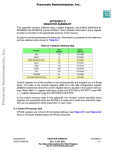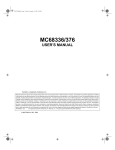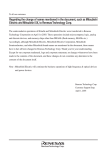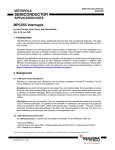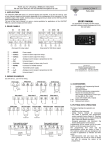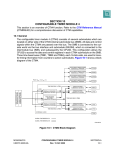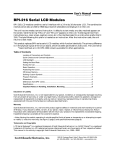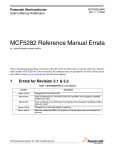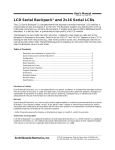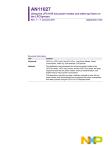Download F re e s c a le S e m ic o n d u c to r, I n c . ..
Transcript
Freescale Semiconductor, Inc. SECTION 13 CAN 2.0B CONTROLLER MODULE (TouCAN) Freescale Semiconductor, Inc... This section is an overview of the TouCAN module. Refer to D.10 TouCAN Module for information concerning TouCAN address map and register structure. 13.1 General The TouCAN module is a communication controller that implements the controller area network (CAN) protocol, an asynchronous communications protocol used in automotive and industrial control systems. It is a high speed (1 Mbit/sec), short distance, priority based protocol which can communicate using a variety of mediums (for example, fiber optic cable or an unshielded twisted pair of wires). The TouCAN supports both the standard and extended identifier (ID) message formats specified in the CAN protocol specification, revision 2.0, part B. The TouCAN module contains 16 message buffers, which are used for transmit and receive functions. It also contains message filters, which are used to qualify the received message IDs when comparing them to the receive buffer identifiers. Figure 13-1 shows a block diagram of the TouCAN. CANTX0 TRANSMITTER 16RX/TX MESSAGE BUFFERS CANTX1* CONTROL RECEIVER CANRX0 CANRX1* SLAVE BUS INTERFACE UNIT IMB * THESE PINS ARE NOT BONDED ON THE MC68376 TOUCAN BLOCK Figure 13-1 TouCAN Block Diagram MC68336/376 USER’S MANUAL CAN 2.0B CONTROLLER MODULE (TouCAN) MOTOROLA Rev. 15 Oct 2000 For More Information On This Product, Go to: www.freescale.com 13-1 Freescale Semiconductor, Inc. 13.2 External Pins The TouCAN module interface to the CAN bus is composed of four pins: CANTX0 and CANTX1, which transmit serial data, and CANRX0 and CANRX1, which receive serial data. Figure 13-2 shows a typical CAN system. NOTE Pins CANTX1 and CANRX1 are not used on the MC68376. Freescale Semiconductor, Inc... CAN STATION 1 CAN STATION 2 CAN STATION n CAN SYSTEM CAN CONTROLLER (TOUCAN) …… CANTX0 CANTX1* CANRX0 CANRX1* TRANSCEIVER * THESE PINS ARE NOT BONDED ON THE MC68376 CAN SYSTEM Figure 13-2 Typical CAN Network Each CAN station is connected physically to the CAN bus through a transceiver. The transceiver provides the transmit drive, waveshaping, and receive/compare functions required for communicating on the CAN bus. It can also provide protection against damage to the TouCAN caused by a defective CAN bus or a defective CAN station. 13.3 Programmer’s Model The TouCAN module address space is split into 128 bytes starting at the base address, and then an extra 256 bytes starting at the base address +128. The upper 256 are fully used for the message buffer structures. Out of the lower 128 bytes, only part is occupied by various registers. Refer to D.10 TouCAN Module for detailed information on the TouCAN address map and register structure. MC68336/376 USER’S MANUAL CAN 2.0B CONTROLLER MODULE (TouCAN) MOTOROLA Rev. 15 Oct 2000 For More Information On This Product, Go to: www.freescale.com 13-2 Freescale Semiconductor, Inc. NOTE The TouCAN has no hard-wired protection against invalid bit/field programming within its registers. Specifically, no protection is provided if the programming does not meet CAN protocol requirements. Freescale Semiconductor, Inc... Programming the TouCAN control registers is typically done during system initialization, prior to the TouCAN becoming synchronized with the CAN bus. The configuration registers can be changed after synchronization by halting the TouCAN module. This is done when the user sets the HALT bit in the TouCAN module configuration register (CANMCR). The TouCAN responds by asserting the CANMCR NOTRDY bit. Additionally, the control registers can be modified while the MCU is in background debug mode. 13.4 TouCAN Architecture The TouCAN module utilizes a flexible design which allows each of its 16 message buffers to be assigned either as a transmit (TX) buffer or a receive (RX) buffer. In addition, to reduce the CPU32 overhead required for message handling each message buffer is assigned an interrupt flag bit to indicate successful completion of transmission or reception, respectively. 13.4.1 TX/RX Message Buffer Structure Figure 13-3 displays the extended (29 bit) ID message buffer structure. Figure 13-4 displays the standard (11 bit) ID message buffer structure. 158 $0 $2 74 TIME STAMP 30 CODE ID[28:18] $4 LENGTH SRR IDE ID[17:15] ID[14:0] ID_HIGH RTR ID_LOW $6 DATA BYTE 0 DATA BYTE 1 $8 DATA BYTE 2 DATA BYTE 3 $A DATA BYTE 4 DATA BYTE 5 $C DATA BYTE 6 DATA BYTE 7 $E CONTROL/STATUS RESERVED Figure 13-3 Extended ID Message Buffer Structure MC68336/376 USER’S MANUAL CAN 2.0B CONTROLLER MODULE (TouCAN) MOTOROLA Rev. 15 Oct 2000 For More Information On This Product, Go to: www.freescale.com 13-3 Freescale Semiconductor, Inc. 15 $0 8 7 TIME STAMP $2 4 3 CODE ID[28:18] $4 0 LENGTH RTR 0 0 0 16-BIT TIME STAMP $6 DATA BYTE 0 DATA BYTE 1 $8 DATA BYTE 2 DATA BYTE 3 $A DATA BYTE 4 DATA BYTE 5 $C DATA BYTE 6 DATA BYTE 7 $E CONTROL/STATUS 0 ID_HIGH ID_LOW RESERVED Freescale Semiconductor, Inc... Figure 13-4 Standard ID Message Buffer Structure 13.4.1.1 Common Fields for Extended and Standard Format Frames Table 13-1 describes the message buffer fields that are common to both extended and standard identifier format frames. Table 13-1 Common Extended/Standard Format Frames Field Description Time Stamp Contains a copy of the high byte of the free running timer, which is captured at the beginning of the identifier field of the frame on the CAN bus. Code Refer to Tables 13-2 and 13-3 RX Length Length (in bytes) of the RX data stored in offset $6 through $D of the buffer. This field is written by the TouCAN module, copied from the DLC (data length code) field of the received frame. TX Length Length (in bytes) of the data to be transmitted, located in offset $6 through $D of the buffer. This field is written by the CPU32, and is used as the DLC field value. If RTR (remote transmission request) = 1, the frame is a remote frame and will be transmitted without data field, regardless of the value in TX length. Data This field can store up to eight data bytes for a frame. For RX frames, the data is stored as it is received from the bus. For TX frames, the CPU32 provides the data to be transmitted within the frame. Reserved This word entry field (16 bits) should not be accessed by the CPU32. MC68336/376 USER’S MANUAL CAN 2.0B CONTROLLER MODULE (TouCAN) MOTOROLA Rev. 15 Oct 2000 For More Information On This Product, Go to: www.freescale.com 13-4 Freescale Semiconductor, Inc. Table 13-2 Message Buffer Codes for Receive Buffers RX Code Before RX New Frame 0000 NOT ACTIVE — message buffer is not active. 0100 EMPTY — message buffer is active and empty. 0010 FULL — message buffer is full. 0110 OVERRUN — second frame was received into a full buffer before the CPU read the first one. 0XY11 Freescale Semiconductor, Inc... Description BUSY — message buffer is now being filled with a new receive frame. This condition will be cleared within 20 cycles. RX Code After RX New Frame Comment — — 0010 — 0110 If a CPU32 read occurs before the new frame, new receive code is 0010. 0010 An empty buffer was filled (XY was 10). 0110 A full/overrun buffer was filled (Y was 1). NOTES: 1. For TX message buffers, upon read, the BUSY bit should be ignored. Table 13-3 Message Buffer Codes for Transmit Buffers Description Code After Successful Transmission RTR Initial TX Code X 1000 0 1100 Data frame to be transmitted once, unconditionally. 1000 1 1100 Remote frame to be transmitted once, and message buffer becomes an RX message buffer for data frames. 0100 0 10101 Data frame to be transmitted only as a response to a remote frame, always. 1010 0 1110 Data frame to be transmitted only once, unconditionally, and then only as a response to remote frame, always. 1010 Message buffer not ready for transmit. — NOTES: 1. When a matching remote request frame is detected, the code for such a message buffer is changed to be 1110. 13.4.1.2 Fields for Extended Format Frames Table 13-4 describes the message buffer fields used only for extended identifier format frames. MC68336/376 USER’S MANUAL CAN 2.0B CONTROLLER MODULE (TouCAN) MOTOROLA Rev. 15 Oct 2000 For More Information On This Product, Go to: www.freescale.com 13-5 Freescale Semiconductor, Inc. Table 13-4 Extended Format Frames Field Description Contains the 14 most significant bits of the extended identifier, located in the ID HIGH word of the ID[28:18]/[17:15] message buffer. Substitute Contains a fixed recessive bit, used only in extended format. Should be set to one by the user for Remote Request TX buffers. It will be stored as received on the CAN bus for RX buffers. (SRR) Freescale Semiconductor, Inc... ID Extended (IDE) If extended format frame is used, this field should be set to one. If zero, standard format frame should be used. ID[14:0] Bits [14:0] of the extended identifier, located in the ID LOW word of the message buffer. Remote Transmission Request (RTR) This bit is located in the least significant bit of the ID LOW word of the message buffer; 0 = Data Frame, 1 = Remote Frame. 13.4.1.3 Fields for Standard Format Frames Table 13-5 describes the message buffer fields used only for standard identifier format frames. Table 13-5 Standard Format Frames Field Description 16-Bit Time Stamp The ID LOW word, which is not needed for standard format, is used in a standard format buffer to store the 16-bit value of the free-running timer which is captured at the beginning of the identifier field of the frame on the CAN bus. ID[28:18] Contains bits [28:18] of the identifier, located in the ID HIGH word of the message buffer. The four least significant bits in this register (corresponding to the IDE bit and ID[17:15] for an extended identifier message) must all be written as logic zeros to ensure proper operation of the TouCAN. RTR RTR/SRR Bit Treatment This bit is located in the ID HIGH word of the message buffer; 0 = data frame, 1 = remote frame. If the TouCAN transmits this bit as a one and receives it as a zero, an “arbitration loss” is indicated. If the TouCAN transmits this bit as a zero and is receives it as a one, a bit error is indicated. If the TouCAN transmits a value and receives a matching response, a successful bit transmission is indicated. 13.4.1.4 Serial Message Buffers To allow double buffering of messages, the TouCAN has two shadow buffers called serial message buffers. These two buffers are used by the TouCAN for buffering both received messages and messages to be transmitted. Only one serial message buffer is active at a time, and its function depends upon the operation of the TouCAN at that time. At no time does the user have access to or visibility of these two buffers. 13.4.1.5 Message Buffer Activation/Deactivation Mechanism Each message buffer must be activated once it is configured for the desired operation by the user. A buffer is activated by writing the appropriate code to the control/status word for that buffer. Once the buffer is activated, it will begin participating in the normal transmit and receive processes. MC68336/376 USER’S MANUAL CAN 2.0B CONTROLLER MODULE (TouCAN) MOTOROLA Rev. 15 Oct 2000 For More Information On This Product, Go to: www.freescale.com 13-6 Freescale Semiconductor, Inc. Likewise, a buffer is deactivated by writing the appropriate deactivation code to the control/status word for that buffer. Deactivation of a buffer is typically done when the user desires to reconfigure the buffer, for example to change the buffer’s function (RX to TX or TX to RX). Deactivation should also be done before changing a receive buffer’s message identifier or before loading a new message to be transmitted into a transmit buffer. Freescale Semiconductor, Inc... For more details on activation and deactivation of message buffers, and the effects on message buffer operation, refer to 13.5 TouCAN Operation. 13.4.1.6 Message Buffer Lock/Release/Busy Mechanism In addition to the activation/deactivation mechanism, the TouCAN also utilizes a lock/ release/busy mechanism to assure data coherency during the receive process. The mechanism includes a lock status for each message buffer, and utilizes the two serial message buffers to facilitate frame transfers within the TouCAN. Reading the control/status word of a receive message buffer triggers the lock for that buffer. While locked, a received message cannot be transferred into that buffer from one of the SMBs. If a message transfer between the message buffer and a serial message buffer is in progress when the control/status word is read, the BUSY status will be indicated in the code field, and the lock will not be activated. The user can release the lock on a message buffer in one of two ways. Reading the control/status word of another message buffer will lock that buffer, releasing the previously locked buffer. A global release can also be performed on any locked message buffer by reading the free-running timer. Once a lock is released, any message transfers between an SMB and a message buffer which was delayed due to that buffer being locked will take place. For more details on the message buffer locking mechanism, and the effects on message buffer operation, refer to 13.5 TouCAN Operation. 13.4.2 Receive Mask Registers The receive mask registers are used as acceptance masks for received frame IDs. The following masks are defined: • A global mask, used for receive buffers 0-13 • Two separate masks for buffers 14 and 15 The value of the mask registers should not be changed during normal operation. If the mask register data is changed after the masked identifier of a received message is matched to a locked message buffer, that message will be transferred into that message buffer once it is unlocked, regardless of whether that message’s masked identifier still matches the receive buffer identifier. Table 13-6 shows mask bit values. MC68336/376 USER’S MANUAL CAN 2.0B CONTROLLER MODULE (TouCAN) MOTOROLA Rev. 15 Oct 2000 For More Information On This Product, Go to: www.freescale.com 13-7 Freescale Semiconductor, Inc. Table 13-6 Receive Mask Register Bit Values Mask Bit Values 0 The corresponding incoming ID bit is “don’t care”. 1 The corresponding ID bit is checked against the incoming ID bit to see if a match exists. Table 13-7 shows mask examples for normal and extended messages. Refer to APPENDIX D REGISTER SUMMARY for more information on RX mask registers. Freescale Semiconductor, Inc... Table 13-7 Mask Examples for Normal/Extended Messages Message Buffer (MB) /Mask Base ID ID[28:18] IDE Extended ID ID[17:0] Match MB2 11111111000 0 — — MB3 1111111100 0 1 MB4 00000011111 0 — — MB5 00000011101 1 010101010101010101 — MB14 11111111000 1 010101010101010101 — RX Global Mask 11111111110 111111100000000001 — RX Message In RX 14 Mask RX Message In 010101010101010101 — 11111111001 1 010101010101010101 31 11111111001 0 — 22 11111111001 1 010101010101010100 —3 01111111000 0 — —4 01111111000 1 010101010101010101 —5 111111100000000000 — 01111111111 10111111000 1 010101010101010101 —6 01111111000 1 010101010101010101 147 NOTES: 1. Match for extended format (MB3). 2. Match for standard format (MB2). 3. No match for MB3 because of ID0. 4. No match for MB2 because of ID28. 5. No match for MB3 because of ID28, match for MB14. 6. No match for MB14 because of ID27. 7. Match for MB14. 13.4.3 Bit Timing The TouCAN module uses three 8-bit registers to set-up the bit timing parameters required by the CAN protocol. Control registers 1 and 2 (CANCTRL1, CANCTRL2) contain the PROPSEG, PSEG1, PSEG2, and the RJW fields which allow the user to configure the bit timing parameters. The prescaler divide register (PRESDIV) allows the user to select the ratio used to derive the S-clock from the system clock. The time quanta clock operates at the S-clock frequency. Table 13-8 provides examples of sys- MC68336/376 USER’S MANUAL CAN 2.0B CONTROLLER MODULE (TouCAN) MOTOROLA Rev. 15 Oct 2000 For More Information On This Product, Go to: www.freescale.com 13-8 Freescale Semiconductor, Inc. tem clock, CAN bit rate, and S-clock bit timing parameters. Refer to APPENDIX D REGISTER SUMMARY for more information on the bit timing registers. Freescale Semiconductor, Inc... Table 13-8 Example System Clock, CAN Bit Rate and S-Clock Frequencies System Clock Frequency (MHz) CAN Bit-Rate (MHz) Possible S-Clock Frequency (MHz) Possible Number of Time Quanta/Bit PRESDIV Value + 1 25 1 25 25 1 20 1 10, 20 10, 20 2, 1 16 1 8, 16 8, 16 2, 1 25 0.125 1, 1.25, 2.5 8,10, 20 25, 20,10 20 0.125 1, 2, 2.5 8, 16, 20 20, 10, 8 16 0.125 1, 2 8,16 16, 8 13.4.3.1 Configuring the TouCAN Bit Timing The following considerations must be observed when programming bit timing functions. • If the programmed PRESDIV value results in a single system clock per one time quantum, then the PSEG2 field in CANCTRL2 register should not be programmed to zero. • If the programmed PRESDIV value results in a single system clock per one time quantum, then the information processing time (IPT) equals three time quanta, otherwise it equals two time quanta. If PSEG2 equals two, then the TouCAN transmits one time quantum late relative to the scheduled sync segment. • If the prescaler and bit timing control fields are programmed to values that result in fewer than ten system clock periods per CAN bit time and the CAN bus loading is 100%, anytime the rising edge of a start-of-frame (SOF) symbol transmitted by another node occurs during the third bit of the intermission between messages, the TouCAN may not be able to prepare a message buffer for transmission in time to begin its own transmission and arbitrate against the message which transmitted the early SOF. • The TouCAN bit time must be programmed to be greater than or equal to nine system clocks, or correct operation is not guaranteed. 13.4.4 Error Counters The TouCAN has two error counters, the transmit (TX) error counter and the receive (RX) error counter. Refer to APPENDIX D REGISTER SUMMARY for more information on error counters. The rules for increasing and decreasing these counters are described in the CAN protocol, and are fully implemented in the TouCAN. Each counter has the following features: • 8-bit up/down counter • Increment by 8 (RX error counter also increments by one) • Decrement by one • Avoid decrement when equal to zero • RX error counter reset to a value between 119 and 127 inclusive, when the MC68336/376 USER’S MANUAL CAN 2.0B CONTROLLER MODULE (TouCAN) MOTOROLA Rev. 15 Oct 2000 For More Information On This Product, Go to: www.freescale.com 13-9 Freescale Semiconductor, Inc. TouCAN transitions from error passive to error active • Following reset, both counters reset to zero • Detect values for error passive, bus off and error active transitions • Cascade usage of TX error counter with an additional internal counter to detect the 128 occurrences of 11 consecutive recessive bits necessary to transition from bus off into error active. Both counters are read only (except in test/freeze/halt modes). Freescale Semiconductor, Inc... The TouCAN responds to any bus state as described in the CAN protocol, transmitting an error active or error passive flag, delaying its transmission start time (error passive) and avoiding any influence on the bus when in the bus off state. The following are the basic rules for TouCAN bus state transitions: • If the value of the TX error counter or RX error counter increments to a value greater than or equal to 128, the fault confinement state (FCS[1:0]) field in the error status register is updated to reflect an error passive state. • If the TouCAN is in an error passive state, and either the TX error counter or RX error counter decrements to a value less than or equal to 127, while the other error counter already satisfies this condition, the FCS[1:0] field in the error status register is updated to reflect an error active state. • If the value of the TX error counter increases to a value greater than 255, the FCS[1:0] field in the error status register is updated to reflect a bus off state, and an interrupt may be issued. The value of the TX error counter is reset to zero. • If the TouCAN is in the bus off state, the TX error counter and an additional internal counter are cascaded to count 128 occurrences of 11 consecutive recessive bits on the bus. To do this, the TX error counter is first reset to zero, then the internal counter begins counting consecutive recessive bits. Each time the internal counter counts 11 consecutive recessive bits, the TX error counter is incremented by one and the internal counter is reset to zero. When the TX error counter reaches the value of 128, the FCS[1:0] field in the error status register is updated to be error active, and both error counters are reset to zero. Any time a dominant bit is detected following a stream of less than 11 consecutive recessive bits, the internal counter resets itself to zero, but does not affect the TX error counter value. • If only one node is operating in a system, the TX error counter will increment with each message it attempts to transmit, due to the resulting acknowledgment errors. However, acknowledgment errors will never cause the TouCAN to transition from the error passive state to the bus off state. • If the RX error counter increments to a value greater than 127, it will stop incrementing, even if more errors are detected while being a receiver. After the next successful message reception, the counter is reset to a value between 119 and 127, to enable a return to the error active state. 13.4.5 Time Stamp The value of the free-running 16-bit timer is sampled at the beginning of the identifier field on the CAN bus. For a message being received, the time stamp will be stored in the time stamp entry of the receive message buffer at the time the message is written MC68336/376 USER’S MANUAL CAN 2.0B CONTROLLER MODULE (TouCAN) MOTOROLA Rev. 15 Oct 2000 For More Information On This Product, Go to: www.freescale.com 13-10 Freescale Semiconductor, Inc. into that buffer. For a message being transmitted, the time stamp entry will be written into the transmit message buffer once the transmission has completed successfully. The free-running timer can optionally be reset upon the reception of a frame into message buffer 0. This feature allows network time synchronization to be performed. Freescale Semiconductor, Inc... 13.5 TouCAN Operation The basic operation of the TouCAN can be divided into three areas: • Reset and initialization of the module • Transmit message handling • Receive message handling Example sequences for performing each of these processes is given in the following paragraphs. 13.5.1 TouCAN Reset The TouCAN can be reset in two ways: • Hard reset, using one of the IMB reset lines. • Soft reset, using the SOFTRST bit in the module configuration register. Following the negation of reset, the TouCAN is not synchronized with the CAN bus, and the HALT, FRZ, and FRZACK bits in the module configuration register are set. In this state, the TouCAN does not initiate frame transmissions or receive any frames from the CAN bus. The contents of the message buffers are not changed following reset. Any configuration change/initialization requires that the TouCAN be frozen by either asserting the HALT bit in the module configuration register or by reset. 13.5.2 TouCAN Initialization Initialization of the TouCAN includes the initial configuration of the message buffers and configuration of the CAN communication parameters following a reset, as well as any reconfiguration which may be required during operation. The following is a generic initialization sequence for the TouCAN: A. Initialize all operation modes 1. Initialize the transmit and receive pin modes in control register 0 (CANCTRL0). 2. Initialize the bit timing parameters PROPSEG, PSEGS1, PSEG2, and RJW in control registers 1 and 2 (CANCTRL[1:2]). 3. Select the S-clock rate by programming the PRESDIV register. 4. Select the internal arbitration mode (LBUF bit in CANCTRL1). B. Initialize message buffers 1. The control/status word of all message buffers must be written either as an active or inactive message buffer. 2. All other entries in each message buffer should be initialized as required. C. Initialize mask registers for acceptance mask as needed MC68336/376 USER’S MANUAL CAN 2.0B CONTROLLER MODULE (TouCAN) MOTOROLA Rev. 15 Oct 2000 For More Information On This Product, Go to: www.freescale.com 13-11 Freescale Semiconductor, Inc. Freescale Semiconductor, Inc... D. Initialize TouCAN interrupt handler 1. Initialize the interrupt configuration register (CANICR) with a specific request level and vector base address. 2. Initialize IARB[3:0] to a non-zero value in CANMCR. 3. Set the required mask bits in the IMASK register (for all message buffer interrupts), in CANCTRL0 (for bus off and error interrupts), and in CANMCR for the WAKE interrupt. E. Negate the HALT bit in the module configuration register 1. At this point, the TouCAN will attempt to synchronize with the CAN bus. NOTE In both the transmit and receive processes, the first action in preparing a message buffer should be to deactivate the buffer by setting its code field to the proper value. This requirement is mandatory to assure data coherency. 13.5.3 Transmit Process The transmit process includes preparing a message buffer for transmission, as well as the internal steps performed by the TouCAN to decide which message to transmit. For the user, this involves loading the message and ID to be transmitted into a message buffer and then activating that buffer as an active transmit buffer. Once this is done, the TouCAN will perform all additional steps necessary to transmit the message onto the CAN bus. The user should prepare/change a message buffer for transmission by executing the following steps. 1. 2. 3. 4. Write the control/status word to hold the transmit buffer inactive (code = %1000) Write the ID_HIGH and ID_LOW words Write the data bytes Write the control/status word (active TX code, TX length) NOTE Steps 1 and 4 are mandatory to ensure data coherency while preparing a message buffer for transmission. Once an active transmit code is written to a transmit message buffer, that buffer will begin participating in an internal arbitration process as soon as the CAN bus is sensed to be free by the receiver, or at the inter-frame space. If there are multiple messages awaiting transmission, this internal arbitration process selects the message buffer from which the next frame is transmitted. When this process is over, and a message buffer is selected for transmission, the frame from that message buffer is transferred to the serial message buffer for transmission. While transmitting, the TouCAN will transmit no more than eight data bytes, even if the transmit length contains a value greater than eight. MC68336/376 USER’S MANUAL CAN 2.0B CONTROLLER MODULE (TouCAN) MOTOROLA Rev. 15 Oct 2000 For More Information On This Product, Go to: www.freescale.com 13-12 Freescale Semiconductor, Inc. At the end of a successful transmission, the value of the free-running timer (which was captured at the beginning of the identifier field on the CAN bus), is written into the time stamp field in the message buffer. The code field in the control/status word of the message buffer is updated and a status flag is set in the IFLAG register. 13.5.3.1 Transmit Message Buffer Deactivation Any write access to the control/status word of a transmit message buffer during the process of selecting a message buffer for transmission immediately deactivates that message buffer, removing it from the transmission process. Freescale Semiconductor, Inc... While a message is being transferred from a transmit message buffer to a serial message buffer, if the user deactivates that transmit message buffer, the message will not be transmitted. If the user deactivates the transmit message buffer after the message is transferred to the serial message buffer, the message will be transmitted, but no interrupt will be requested and the transmit code will not be updated. If a message buffer containing the lowest ID is deactivated while that message is undergoing the internal arbitration process to determine which message should be sent, then that message may not be transmitted. 13.5.3.2 Reception of Transmitted Frames The TouCAN will receive a frame it has transmitted if an empty message buffer with a matching identifier exists. 13.5.4 Receive Process The receive process includes configuring message buffers for reception, the transfer of received messages by the TouCAN from the serial message buffers to the receive message buffers with matching IDs, and the retrieval of these messages by the user. The user should prepare/change a message buffer for frame reception by executing the following steps. 1. Write the control/status word to hold the receive buffer inactive (code = %0000). 2. Write the ID_HIGH and ID_LOW words. 3. Write the control/status word to mark the receive message buffer as active and empty. NOTE Steps 1 and 3 are mandatory for data coherency while preparing a message buffer for reception. Once these steps are performed, the message buffer functions as an active receive buffer and participates in the internal matching process, which takes place every time the TouCAN receives an error-free frame. In this process, all active receive buffers compare their ID value to the newly received one. If a match is detected, the following actions occur: MC68336/376 USER’S MANUAL CAN 2.0B CONTROLLER MODULE (TouCAN) MOTOROLA Rev. 15 Oct 2000 For More Information On This Product, Go to: www.freescale.com 13-13 Freescale Semiconductor, Inc. Freescale Semiconductor, Inc... 1. The frame is transferred to the first (lowest entry) matching receive message buffer. 2. The value of the free-running timer (captured at the beginning of the identifier field on the CAN bus) is written into the time stamp field in the message buffer. 3. The ID field, data field and RX length field are stored. 4. The code field is updated. 5. The status flag is set in the IFLAG register. The user should read a received frame from its message buffer in the following order: 1. Control/status word (mandatory, as it activates the internal lock for this buffer) 2. ID (optional, since it is needed only if a mask was used) 3. Data field word(s) 4. Free-running timer (optional, as it releases the internal lock) If a read of the free running timer is not performed, that message buffer remains locked until the read process starts for another message buffer. Only a single message buffer is locked at a time. When reading a received message, the only mandatory read operation is that of the control/status word. This assures data coherency. If the BUSY bit is set in the message buffer code, the CPU32 should defer accessing that buffer until this bit is negated. Refer to Table 13-2. NOTE The CPU32 should check the status of a message buffer by reading the status flag in the IFLAG register and not by reading the control/ status word code field for that message buffer. This prevents the buffer from being locked inadvertently. Because the received identifier field is always stored in the matching receive message buffer, the contents of the identifier field in a receive message buffer may change if one or more of the ID bits are masked. 13.5.4.1 Receive Message Buffer Deactivation Any write access to the control/status word of a receive message buffer during the process of selecting a message buffer for reception immediately deactivates that message buffer, removing it from the reception process. If a receive message buffer is deactivated while a message is being transferred into it, the transfer is halted and no interrupt is requested. If this occurs, that receive message buffer may contain mixed data from two different frames. Data should never be written into a receive message buffer. If this is done while a message is being transferred from a serial message buffer, the control/status word will reflect a full or overrun condition, but no interrupt will be requested. 13.5.4.2 Locking and Releasing Message Buffers The lock/release/busy mechanism is designed to guarantee data coherency during the receive process. The following examples demonstrate how the lock/release/busy MC68336/376 USER’S MANUAL CAN 2.0B CONTROLLER MODULE (TouCAN) MOTOROLA Rev. 15 Oct 2000 For More Information On This Product, Go to: www.freescale.com 13-14 Freescale Semiconductor, Inc. Freescale Semiconductor, Inc... mechanism will affect TouCAN operation. 1. Reading a control/status word of a message buffer triggers a lock for that message buffer. A new received message frame which matches the message buffer cannot be written into this message buffer while it is locked. 2. To release a locked message buffer, the CPU32 either locks another message buffer by reading its control/status word, or globally releases any locked message buffer by reading the free-running timer. 3. If a receive frame with a matching ID is received during the time the message buffer is locked, the receive frame will not be immediately transferred into that message buffer, but will remain in the serial message buffer. There is no indication when this occurs. 4. When a locked message buffer is released, if a frame with a matching identifier exists within the serial message buffer, then this frame will be transferred to the matching message buffer. 5. If two or more receive frames with matching IDs are received while a message buffer with a matching ID is locked, the last received frame with that ID is kept within the serial message buffer, while all preceding ones are lost. There is no indication when this occurs. 6. If the user reads the control/status word of a receive message buffer while a frame is being transferred from a serial message buffer, the BUSY code will be indicated. The user should wait until this code is cleared before continuing to read from the message buffer to ensure data coherency. In this situation, the read of the control/status word will not lock the message buffer. Polling the control/status word of a receive message buffer can lock it, preventing a message from being transferred into that buffer. If the control/status word of a receive message buffer is read, it should then be followed by a read of the control/status word of another buffer, or by reading the free-running timer, to ensure that the locked buffer is unlocked. 13.5.5 Remote Frames The remote frame is a message frame which is transmitted to request a data frame. The TouCAN can be configured to transmit a data frame automatically in response to a remote frame, or to transmit a remote frame and then wait for the responding data frame to be received. When transmitting a remote frame, the user initializes a message buffer as a transmit message buffer with the RTR bit set to one. Once this remote frame is transmitted successfully, the transmit message buffer automatically becomes a receive message buffer, with the same ID as the remote frame which was transmitted. When a remote frame is received by the TouCAN, the remote frame ID is compared to the IDs of all transmit message buffers programmed with a code of 1010. If there is an exact matching ID, the data frame in that message buffer is transmitted. If the RTR bit in the matching transmit message buffer is set, the TouCAN will transmit a remote frame as a response. MC68336/376 USER’S MANUAL CAN 2.0B CONTROLLER MODULE (TouCAN) MOTOROLA Rev. 15 Oct 2000 For More Information On This Product, Go to: www.freescale.com 13-15 Freescale Semiconductor, Inc. A received remote frame is not stored in a receive message buffer. It is only used to trigger the automatic transmission of a frame in response. The mask registers are not used in remote frame ID matching. All ID bits (except RTR) of the incoming received frame must match for the remote frame to trigger a response transmission. Freescale Semiconductor, Inc... 13.5.6 Overload Frames Overload frame transmissions are not initiated by the TouCAN unless certain conditions are detected on the CAN bus. These conditions include: • Detection of a dominant bit in the first or second bit of intermission. • Detection of a dominant bit in the seventh (last) bit of the end-of-frame (EOF) field in receive frames. • Detection of a dominant bit in the eighth (last) bit of the error frame delimiter or overload frame delimiter. 13.6 Special Operating Modes The TouCAN module has three special operating modes: • Debug mode • Low-power stop mode • Auto power save mode 13.6.1 Debug Mode Debug mode is entered by setting the HALT bit in the CANMCR, or by assertion of the IMB FREEZE line. In both cases, the FRZ1 bit in CANMCR must also be set to allow HALT or FREEZE to place the TouCAN in debug mode. Once entry into debug mode is requested, the TouCAN waits until an intermission or idle condition exists on the CAN bus, or until the TouCAN enters the error passive or bus off state. Once one of these conditions exists, the TouCAN waits for the completion of all internal activity. When this happens, the following events occur: • The TouCAN stops transmitting/receiving frames. • The prescaler is disabled, thus halting all CAN bus communication. • The TouCAN ignores its RX pins and drives its TX pins as recessive. • The TouCAN loses synchronization with the CAN bus and the NOTRDY and FRZACK bits in CANMCR are set. • The CPU32 is allowed to read and write the error counter registers. After engaging one of the mechanisms to place the TouCAN in debug mode, the user must wait for the FRZACK bit to be set before accessing any other registers in the TouCAN, otherwise unpredictable operation may occur. To exit debug mode, the IMB FREEZE line must be negated or the HALT bit in CANMCR must be cleared. MC68336/376 USER’S MANUAL CAN 2.0B CONTROLLER MODULE (TouCAN) MOTOROLA Rev. 15 Oct 2000 For More Information On This Product, Go to: www.freescale.com 13-16 Freescale Semiconductor, Inc. Once debug mode is exited, the TouCAN will resynchronize with the CAN bus by waiting for 11 consecutive recessive bits before beginning to participate in CAN bus communication. Freescale Semiconductor, Inc... 13.6.2 Low-Power Stop Mode Before entering low-power stop mode, the TouCAN will wait for the CAN bus to be in an idle state, or for the third bit of intermission to be recessive. The TouCAN then waits for the completion of all internal activity (except in the CAN bus interface) to be complete. Afterwards, the following events occur: • The TouCAN shuts down its clocks, stopping most internal circuits, thus achieving maximum power savings. • The bus interface unit continues to operate, allowing the CPU32 to access the module configuration register. • The TouCAN ignores its RX pins and drives its TX pins as recessive. • The TouCAN loses synchronization with the CAN bus, and the STOPACK and NOTRDY bits in the module configuration register are set. To exit low-power stop mode: • Reset the TouCAN either by asserting one of the IMB reset lines or by asserting the SOFTRST bit CANMCR. • Clear the STOP bit in CANMCR. • The TouCAN module can optionally exit low-power stop mode via the self-wake mechanism. If the SELFWAKE bit in CANMCR was set at the time the TouCAN entered stop mode, then upon detection of a recessive to dominant transition on the CAN bus, the TouCAN clears the STOP bit in CANMCR and its clocks begin running. When in low-power stop mode, a recessive to dominant transition on the CAN bus causes the WAKEINT bit in the error and status register (ESTAT) to be set. This event can generate an interrupt if the WAKEMSK bit in CANMCR is set. Consider the following notes regarding low-power stop mode: • When the self-wake mechanism activates, the TouCAN tries to receive the frame that woke it up. (It assumes that the dominant bit detected is a start-of-frame bit). It will not arbitrate for the CAN bus at this time. • If the STOP bit is set while the TouCAN is in the bus off state, then the TouCAN will enter low-power stop mode and stop counting recessive bit times. The count will continue when STOP is cleared. • To place the TouCAN in low-power stop mode with the self-wake mechanism engaged, write to CANMCR with both STOP and SELFWAKE set, then wait for the TouCAN to set the STOPACK bit. • To take the TouCAN out of low-power stop mode when the self-wake mechanism is enabled, write to CANMCR with both STOP and SELFWAKE clear, then wait for the TouCAN to clear the STOPACK bit. • The SELFWAKE bit should not be set after the TouCAN has already entered lowpower stop mode. MC68336/376 USER’S MANUAL CAN 2.0B CONTROLLER MODULE (TouCAN) MOTOROLA Rev. 15 Oct 2000 For More Information On This Product, Go to: www.freescale.com 13-17 Freescale Semiconductor, Inc... Freescale Semiconductor, Inc. • If both STOP and SELFWAKE are set and a recessive to dominant edge immediately occurs on the CAN bus, the TouCAN may never set the STOPACK bit, and the STOP bit will be cleared. • To prevent old frames from being sent when the TouCAN awakes from low-power stop mode via the self-wake mechanism, disable all transmit sources, including transmit buffers configured for remote request responses, before placing the TouCAN in low-power stop mode. • If the TouCAN is in debug mode when the STOP bit is set, the TouCAN will assume that debug mode should be exited. As a result, it will try to synchronize with the CAN bus, and only then will it await the conditions required for entry into low-power stop mode. • Unlike other modules, the TouCAN does not come out of reset in low-power stop mode. The basic TouCAN initialization procedure (see 13.5.2 TouCAN Initialization) should be executed before placing the module in low-power stop mode. • If the TouCAN is in low-power stop mode with the self-wake mechanism engaged and is operating with a single system clock per time quantum, there can be extreme cases in which TouCAN wake-up on recessive to dominant edge may not conform to the CAN protocol. TouCAN synchronization will be shifted one time quantum from the wake-up event. This shift lasts until the next recessive to dominant edge, which resynchronizes the TouCAN to be in conformance with the CAN protocol. The same holds true when the TouCAN is in auto power save mode and awakens on a recessive to dominant edge. 13.6.3 Auto Power Save Mode Auto power save mode enables normal operation with optimized power savings. Once the auto power save (APS) bit in CANMCR is set, the TouCAN looks for a set of conditions in which there is no need for the clocks to be running. If these conditions are met, the TouCAN stops its clocks, thus saving power. The following conditions will activate auto power save mode. • No RX/TX frame in progress. • No transfer of RX/TX frames to and from a serial message buffer, and no TX frame awaiting transmission in any message buffer. • No CPU32 access to the TouCAN module. • The TouCAN is not in debug mode, low-power stop mode, or the bus off state. While its clocks are stopped, if the TouCAN senses that any one of the aforementioned conditions is no longer true, it restarts its clocks. The TouCAN then continues to monitor these conditions and stops/restarts its clocks accordingly. 13.7 Interrupts The TouCAN is capable of generating one interrupt level on the IMB. This level is programmed into the priority level bits in the interrupt configuration register (CANICR). This value determines which interrupt signal is driven onto the bus when an interrupt is requested. When an interrupt is requested, the CPU32 initiates an IACK cycle. The TouCAN decodes the IACK cycle and compares the CPU32 recognized level to the level that it MC68336/376 USER’S MANUAL CAN 2.0B CONTROLLER MODULE (TouCAN) MOTOROLA Rev. 15 Oct 2000 For More Information On This Product, Go to: www.freescale.com 13-18 Freescale Semiconductor, Inc. is currently requesting. If a match occurs, then arbitration begins. If the TouCAN wins arbitration, it generates a uniquely encoded interrupt vector that indicates which event is requesting service. This encoding scheme is as follows: Freescale Semiconductor, Inc... • The higher-order bits of the interrupt vector come from the IVBA[2:0] field in CANICR. • The low-order five bits are an encoded value that indicate which of the 19 TouCAN interrupt sources is requesting service. Figure 13-5 shows a block diagram of the interrupt hardware. INTERRUPT REQUEST LEVEL (ILCAN[2:0] MASKS BUFFER INTERRUPTS BUS OFF ERROR 3 INTERRUPT LEVEL DECODER 7 IRQ[7:1] 19 16 19 INTERRUPT PRIORITY ENCODER 5 MODULE INTERRUPT VECTOR INTERRUPT ENABLE LOGIC 3 WAKE UP VECTOR BASE ADDRESS (IVBA[2:0]) 3 TOUCAN INTERRUPT GEN Figure 13-5 TouCAN Interrupt Vector Generation Each one of the 16 message buffers can be an interrupt source, if its corresponding IMASK bit is set. There is no distinction between transmit and receive interrupts for a particular buffer. Each of the buffers is assigned a bit in the IFLAG register. An IFLAG bit is set when the corresponding buffer completes a successful transmission/reception. An IFLAG bit is cleared when the CPU32 reads IFLAG while the associated bit is set, and then writes it back as zero (and no new event of the same type occurs between the read and the write actions). The other three interrupt sources (bus off, error and wake up) act in the same way, and have flag bits located in the error and status register (ESTAT). The bus off and error interrupt mask bits (BOFFMSK and ERRMSK) are located in CANCTRL0, and the wake up interrupt mask bit (WAKEMSK) is located in the module configuration register. Refer to APPENDIX D REGISTER SUMMARY for more information on these registers. Table 13-9 shows TouCAN interrupt priorities and their corresponding vector addresses. MC68336/376 USER’S MANUAL CAN 2.0B CONTROLLER MODULE (TouCAN) MOTOROLA Rev. 15 Oct 2000 For More Information On This Product, Go to: www.freescale.com 13-19 Freescale Semiconductor, Inc. Freescale Semiconductor, Inc... Table 13-9 Interrupt Sources and Vector Addresses MC68336/376 USER’S MANUAL Interrupt Source Vector Number Buffer 0 %XXX00000 (Highest priority) Buffer 1 %XXX00001 Buffer 2 %XXX00010 Buffer 3 %XXX00011 Buffer 4 %XXX00100 Buffer 5 %XXX00101 Buffer 6 %XXX00110 Buffer 7 %XXX00111 Buffer 8 %XXX01000 Buffer 9 %XXX01001 Buffer 10 %XXX01010 Buffer 11 %XXX01011 Buffer 12 %XXX01100 Buffer 13 %XXX01101 Buffer 14 %XXX01110 Buffer 15 %XXX01111 Bus off %XXX10000 Error %XXX10001 Wake-up %XXX10010 (Lowest priority) CAN 2.0B CONTROLLER MODULE (TouCAN) MOTOROLA Rev. 15 Oct 2000 For More Information On This Product, Go to: www.freescale.com 13-20




















